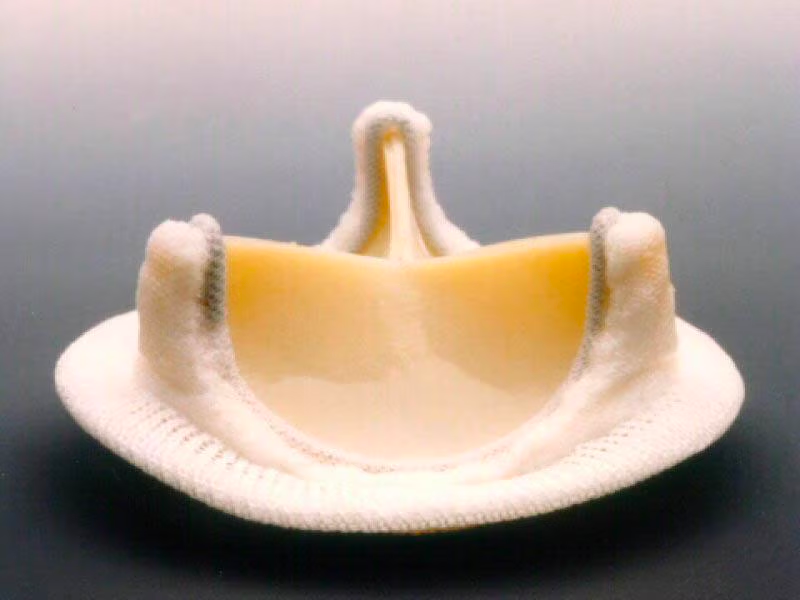Hello everyone and welcome back to Aortic Disease Awareness month! We previously spoke about aortic valve disease and some of the ways our valves may fail over time. Remind me again, what is it called when an aortic valve becomes too tight? Comment below!
Today, we are going to shift gears a bit and talk about how doctors can help treat aortic valve disease.
While mild and moderate disease may be monitored over time with repeat echocardiography and controlling risk factors such as high blood pressure and smoking, once the threshold for severe aortic stenosis or regurgitation is met, the only treatment known to prolong life expectancy and improve symptoms is aortic valve replacement.
Valve Selection
When deciding to undergo aortic valve replacement one of the primary considerations you and your doctor will make is whether to receive a mechanical or bioprosthetic valve. Each of them offers unique benefits and drawbacks.
A mechanical valve is the most durable and long-lasting valve, often pumping for 20-30 years before they start to wear down again. This is why they are often the primary choice in younger patients.
The main drawback of mechanical valves is that they are more likely to cause small blood clots which can increase the risk of stroke or heart attack. Therefore patients will require life-long blood thinners such as Coumadin (warfarin).
They will also have to get routine blood work to make sure their blood “thickness'' is within a safe range. In addition, some patients have reported hearing a “clicking” sound as the valve opens and closes, which takes some time to get used to it.
Alternatively, patients can consider bioprosthetic valves, which are made using tissue from either a cow (bovine valve) or pig (porcine valve). These valves have a lower risk of thrombosis, and most patients do not have to be on life-long blood thinners their whole life. However, unlike their mechanical counterparts, bioprosthetic valves are more susceptible to calcium buildup over time leading to premature structural valve deterioration.
Their durability is estimated to be between 10 and 20 years, which may not be an issue in elderly patients whose expected life expectancy is within this range. However, younger patients who undergo bioprosthetic valve replacement and “outlive” their valve will need a second valve replacement in their lifetime.
SAVR v TAVR
Aortic valve replacement can be done one of two ways:
The traditional approach is surgical aortic valve replacement (SAVR), is open-heart surgery which allows doctors to remove the diseased valve and replace it takes over function.
The benefits of this technique are that it allows direct visualization of the valve and surrounding tissue, allowing surgeons to cut out any diseased tissue and calcium before suturing a new valve in place.
Also for patients presenting with BOTH aortic valve disease and aortic vessel disease (such as a bicuspid aortic valve with an aortic aneurysm), surgery will allow both to be fixed.
However, open-heart surgery carries the risks of being an invasive operation, requiring patients to take anywhere between 1 to 3 months off from work to recover.
Alternatively, several advancements have been made in a “transcatheter aortic valve replacement,” also known as TAVR. In this procedure, either an interventional cardiologist or a surgeon will make a small cut in your groin, shoulder, or neck and use a catheter to deliver a guide wire through a peripheral artery into the aorta under radiological imaging.
A compressed prosthetic valve will then be looped over the guidewire to the position of the aortic valve and expanded to take over function of the diseased valve.
The procedure only takes 45 minutes to an hour and a half (4 to 5 hours for SAVR) and patients usually spend 1 to 2 days in the hospital, returning work shortly after.
Some potential drawbacks of TAVR are an elevated risk of putting in a mis-sized valve (patient-prosthesis mismatch) and the need for a permanent pacemaker, as delivery of the wire and valve may cause damage to the native electrical conduction system of the heart. Additionally, patients will need peripheral arteries large enough to allow passage of the wire and catheters without damaging the native vessels.
When deciding between SAVR or TAVR your doctor will consider several risk factors including your age, risk factors and anatomy.
Older patients (>75 years old) with several comorbidities tend to be offered TAVR over SAVR as the procedure is less physically demanding and results in a faster recovery. It is worth noting that all currently FDA-approved TAVR valves utilize a bioprosthetic frame, which means they are subject to structural valve deterioration over time.
Younger patients (</= 65 years) who can physically tolerate open-heart surgery tend to recommend SAVR over TAVR. The use of SAVR in this population also gives patients the option of receiving a mechanical valve, which may be beneficial given their longer life-expectancy. For patients with other anatomical or disease risk factors, such as bicuspid aortic valves or concomitant aortic root or coronary artery disease, SAVR may also be preferable.
And that's it for today's post! Thank you for tuning in and have a great day!
Adham





Comments